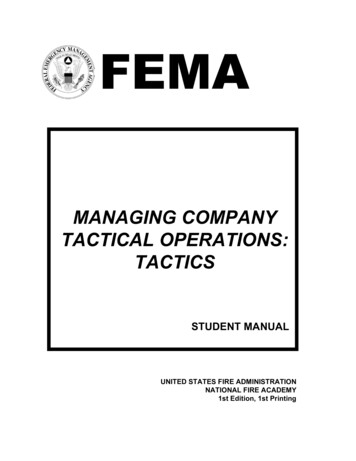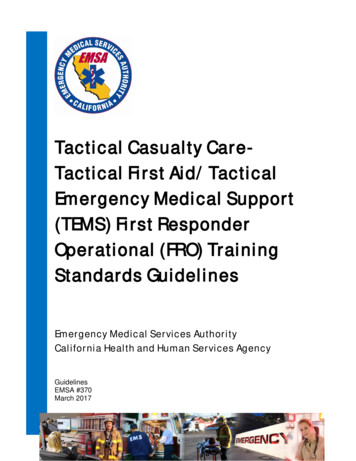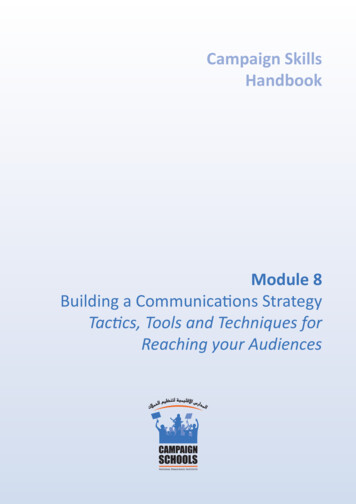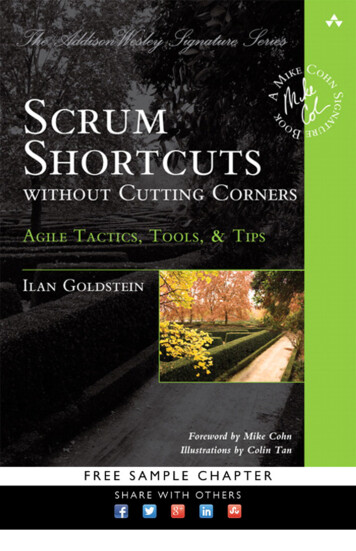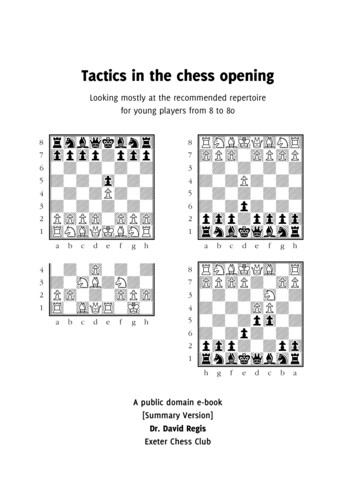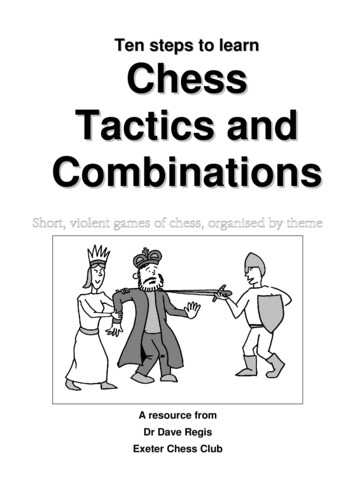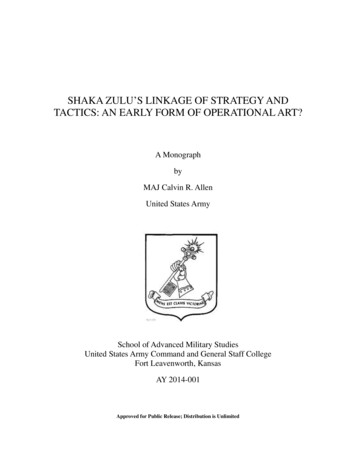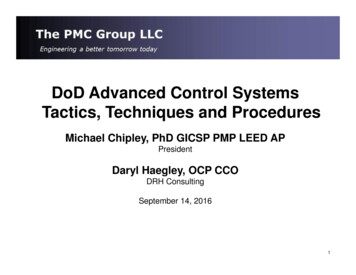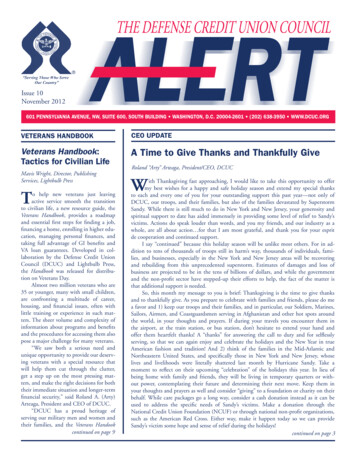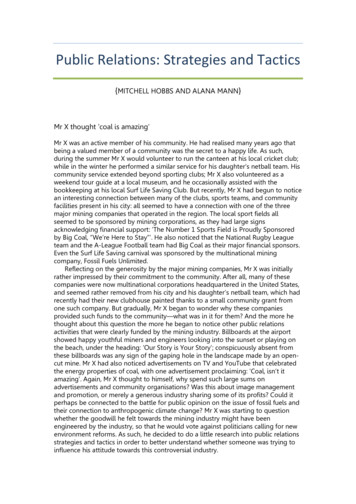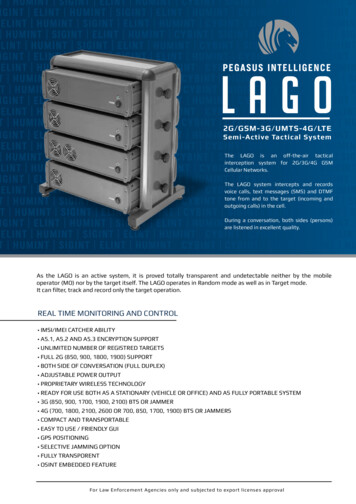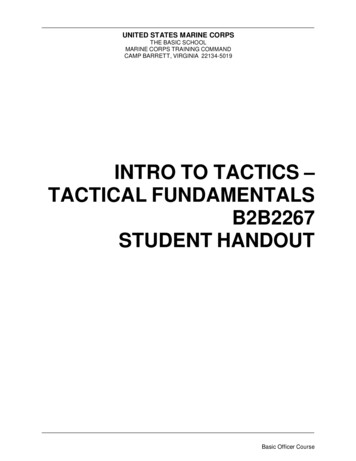
Transcription
UNITED STATES MARINE CORPSTHE BASIC SCHOOLMARINE CORPS TRAINING COMMANDCAMP BARRETT, VIRGINIA 22134-5019INTRO TO TACTICS –TACTICAL FUNDAMENTALSB2B2267STUDENT HANDOUTBasic Officer Course
Tactical Fundamentals – Intro to TacticsB2B2267Tactical FundamentalsIntroduction and ImportanceThe Marine Corps prides itself in warfighting excellence. Integral to this is a leader’s ability,regardless of rank or billet, to not only make timely decisions, but tactically sound decisions. Tacticalleaders hone their warfighting skills through the focused study of tactics, utilizing the nine principles ofwar and the six tactical tenets. When properly applied, the nine principles of war and the six tacticaltenets provide the transition from the theoretical application of tactics to the practical.PrerequisitesKeep the following references in mind as you read this handout:MCDP 1 Warfighting, introduced you to the inherently violent and chaotic nature of war.We mitigate this through clear communication of intent and simple plans, but must always understandthat chaos can never be completely removed. The Marine Corps concept for winning under theseconditions is maneuver warfare, the theory of which is to strike the enemy’s critical vulnerability at thedecisive time and place, with massed fires to bend the enemy to our will. (Warfighting)MCDP 1-3 Tactics, used Warfighting as its base, and expounded on how we fight, the artand science of warfare, and introduced you to the tactical tenets by chapter. (MCDP 1-3 Tactics)In This LessonThis lesson will give you a framework for making sound tactical decisions and understanding thedecision making process at the tactical level of war. At its core are two evaluative concepts: the nineprinciples of war, and the six tactical tenets. These concepts form the basis you will use to make andevaluate sound decisions in the future.ContentsTopicTactical Tenets and the Principles of WarThe Art and The Science of TacticsThe Principles of WarThe Tactical Tenets: Achieving a DecisionThe Tactical Tenets: Gaining an AdvantageThe Tactical Tenets: Being FasterThe Tactical Tenets: AdaptingThe Tactical Tenets: CooperatingThe Tactical Tenets: Exploiting Success and FinishingSummary / References / GlossaryPage345791012131415Learning Objectives1. While serving as a leader of Marines, be technically and tactically proficient to support themission of the Marine Corps and maintain combat readiness. (MCCS-CORE-2102)2. While serving as a leader of Marines, make sound and timely decisions to support the missionof the Marine Corps and maintain combat readiness. (MCCS-CORE-2104)3. Without the aid of references, describe the principles of war without error. (MCCS-OFF-2102i)4. Without the aid of references, describe the maneuver warfare concepts without error. (MCCSOFF-2102j)2Basic Officer Course
Tactical Fundamentals – Intro to TacticsB2B2267The Principles of War and the Tactical TenetsThe discussion of tactics and the nine principles of war is one founded in doctrine, laid in MCDP 1Warfighting. MCDP 1 also lays the foundation for the Marine Corps’ use of doctrine, in which it states,“Our doctrine does not consist of procedures to be applied in specific situations so much as it sets forthgeneral guidance that requires judgment in application. Therefore, while authoritative, doctrine is notprescriptive.” (Warfighting, 56) In short, to effectively apply our tactical doctrine, one must not look for theformula in which to apply the theory, but rather understand the theory itself and recognize when andwhere it is applicable.Tactics is “the art and science of winning engagements and battles ” (Warfighting, 30).Specifically, it refers to the concepts and methods we use to accomplish a particular objective in eithercombat or military operations other than war. In war, tactics “ includes the use of firepower andmaneuver, the integration of different arms, and the immediate exploitation of successes to defeat theenemy.” (Warfighting, 30) In addition to the application of firepower, tactics is also focused on thesustainment of forces during combat. (MCDP 1-3 Tactics, 3)The Marine Corps’ warfighting philosophy of maneuver warfare is rooted in the nine principles ofwar (Marine Corps Operations, B-1). Commonly identified by the acronym MOOSEMUSS, they arecentral to the understanding of tactics, and are at the heart of the practical application of tactical theory.The principles of war lend, “rigor and focus to the purely creative aspects of tactics and provide a cruciallink between pure theory and actual application.” (FM 3-90 Tactics, 2-3)In combat our objective is victory. (MCDP 1-3 Tactics, 5) Key to accomplishing our objective liesin the successful execution of Marine Corps tactics. This execution “ hinges on the thoughtfulapplication of a number of tactical concepts so as to achieve success on the battlefield.” (MCDP 1-3Tactics, 11) Following is the list of “tactical tenets”: Achieving a decision.Gaining an advantage.Being faster.Adapting.Cooperating.Exploiting success and finishing.These concepts are not stand-alone ideas but are combined so as to achieve an effect that isgreater than their separate sum. Part of the art and science of tactics lies in knowing where and when toapply these concepts and which combinations to use to achieve the desired effect. (MCDP 1-3 Tactics,11) Before we discuss the details of each tenet we will first gain a better understanding of the art andscience of tactics.3Basic Officer Course
Tactical Fundamentals – Intro to TacticsB2B2267The Art and the Science of TacticsThe Art of TacticsThe art of tactics lies in how we creatively form and apply military force in a given situation. Itinvolves the creation, positioning, and maneuver of combat power. For example, understanding tacticsallows us to answer questions such as: When do we attack the enemy using a frontal, flanking, orenveloping attack? This creativity is a developed capacity acquired through education, practice, andexperience. (MCDP 1-3 Tactics, 4)The Science of TacticsThe science of tactics lies in the technical application of combat power. It includes mastering thetechniques and procedures that contribute to the warfighting skills such as marksmanship, gunnery, landnavigation, and close air support. The execution of these techniques and procedures must becomesecond nature to us, requiring intensive and continuous training. Without mastery of basic warfightingskills, artistry and creativity in their application are impossible. We must always strive for “brilliance in thebasics” at all levels to ensure success. (MCDP 1-3 Tactics, 4)The Common QuestionThe common question asked when attempting to understand the art and the science of tactics is,which is more important? The true tactician realizes that the question itself is flawed, in that it makes theassumption that one is more important than the other. Tactical victory is achieved when art and scienceare applied with equal weight. A common acronym used in the Marine Corps is TTPs or tactics,techniques, and procedures. TTPs is used commonplace to describe the way in which the Marine Corpsdoes nearly everything. All MOSs (military occupational specialties) have established TTPs that governtheir day-to-day operations. It is fitting then, that TTP itself embodies both the art and the science oftactics. Within the acronym, “tactics” refers to the art, while “techniques and procedures” is the science.It is evident that to truly achieve victory, one must apply a unique combination of art and science to everyproblem.4Basic Officer Course
Tactical Fundamentals – Intro to TacticsB2B2267The Principles of WarThe nine principles of war are aids to a leader as they consider how to accomplish a mission. Asopposed to being prescriptive steps or actions that must be accomplished, they are guidelines forconducting operations through all the levels of war; strategic, operational, and tactical. (Warfighting, 2832) Sightless adherence to these principles will not guarantee success, but each deviation increases risk.It is the tactician who will thoughtfully apply these principles, recognizing the risk versus gain of anyomission, to focus their tactical thought into execution. The nine Principles of War are easily rememberedby the acronym MOOSEMUSS. They are defined below:MassThe concept of “concentrating the effects of combat power at the decisive place and time toachieve decisive results.” (Marine Corps Operations, B-1) As you learned in Warfighting, we must firstidentify which factors are critical to the enemy, and then identify a relative weakness to that strength – thisis the enemy’s critical vulnerability. Vital to the concept of mass is having the insight to identify thedecisive place and time in which to attack the enemy’s critical vulnerability. Concentrated fire power isirrelevant if applied to an objective of no significance. We seek mass to overwhelm the enemy in anattempt to deliver the decisive blow. It applies not only to fires, but supporting elements as well. It isclosely related to economy of force, as force available is limited and we must decide when and where it isappropriate to mass or economize our force.ObjectiveThe concept of “direct[ing] every military operation toward a clearly defined, decisive, andattainable objective.” (Marine Corps Operations, B-2) Related to mass and economy of force, we mustknow where to mass and where to economize, which is defined by a decisive objective. It is also relatedto unity of command, as each subordinate must be lead by the intent of one commander, towards thecommonly defined objective. Communication is also critical, ensuring that the elements of the militaryoperation are acting in consonance towards the same end.OffensiveThe concept that we, as a fighting force, are continuously focused on “seiz[ing], retain[ing], andexploit[ing] the initiative.” (Marine Corps Operations, B-2) Maintaining an offensive mindset does notimply that we seek to avoid defense. Rather it implies the use of the defense as a temporary expedient toprepare to resume the offense. Offense being the decisive form of combat, it is the method by which weexploit the enemy weakness, impose our will, and determine the course of war.SecurityThe concept of “never permit[ing] the enemy to acquire an unexpected advantage.” (MarineCorps Operations, B-2) We look to, at appropriate times and places, adopt measures to prevent theenemy from imposing their will on us faster than we can react. It allows us to ensure our freedom ofaction on the battlefield and preserve our combat power for decisive action. It does not imply the overapplication of caution to eliminate risk, but rather seeks to enhance our operations through boldmaneuver and acceptance of calculated risk.Economy of ForceThe concept of “allocat[ing] minimum essential combat power to secondary efforts.” (MarineCorps Operations, B-3) This goes hand-in-hand with the concept of mass. In order for us to concentratedecisive combat power at the decisive point, we must know where to economize forces at our secondaryefforts. This also implies an acceptance of calculated risk at these secondary efforts. Limited attacks,defense, deceptions, or delaying actions can help us economize forces allowing us to weight the maineffort with mass.5Basic Officer Course
Tactical Fundamentals – Intro to TacticsB2B2267The Principles of War (Continued)ManeuverThe concept that we seek to “place the enemy in a disadvantageous position through the flexibleapplication of combat power.” (Marine Corps Operations, B-3) The traditional understanding of maneuveris a spatial one; that is, we maneuver in space to gain a positional advantage. (JP 1-02, 200) However, inorder to maximize the usefulness of maneuver, we must consider maneuver in other dimensions as well.The essence of maneuver is taking action to generate and exploit some kind of advantage over theenemy as a means of accomplishing our objectives as effectively as possible. That advantage may bepsychological, technological, or temporal as well as spatial. Especially important is maneuver in time—wegenerate a faster operating tempo than the enemy to gain a temporal advantage. It is through maneuverin all dimensions that an inferior force can achieve decisive superiority at the necessary time and place.(Warfighting, 72) Maneuver alone will not defeat a force, however maneuver in conjunction with Mass,Surprise, and Economy of Force allows a seemingly inferior force to achieve decisive superiority at thenecessary time and place.Unity of CommandBest exemplified by commander’s intent, “Unity of Command” is the concept that “for everyobjective, [we] ensure unity of effort under one responsible commander.” (Marine Corps Operations, B-4)Mass, economy of force, and maneuver would be impossible without the vision of a single leader. Toensure that vision is carried to the lowest levels while still allowing for flexibility and initiative we usecommander’s intent. It allows for and leverages mass, objective, and economy of force at the decisivepoint.SurpriseThe concept that we seek to “strike the enemy at a time or place or in a manner for which he isunprepared.” (Marine Corps Operations, B-4) It does not require the enemy to be caught unaware, butrather that he becomes aware too late to react effectively. May include the use of speed (maneuver intime), unexpected forces (mass), operating at night (psychological and technological maneuver),deception (psychological maneuver), security, variation in techniques, and use of unfavorable terrain(spatial maneuver).SimplicityThe concept that the preparation of “clear, uncomplicated plans and clear, concise ordersensures thorough understanding” (Marine Corps Operations, B-4) and therefore ease of execution. Plansand orders should be as simple and direct as the situation and mission dictate. This reduces the chanceof misunderstandings that inject internal friction and therefore cause ineffective execution. Ceterisparibus (all variables being equal), the simplest plan is preferred.6Basic Officer Course
Tactical Fundamentals – Intro to TacticsB2B2267The Tactical Tenets – Achieving a DecisionIn the past, military forces often won only incremental gains when they sought victory – taking ahill or a town, pushing forward only a few kilometers or adding to the body count. Sometimes theseincremental gains were a result of a competent enemy or the chaotic nature of war. However, many timescommanders sought incremental gains as a means to achieve victory. Therefore, the Marine Corps hasembraced a more flexible, imaginative, and effective way to wage war called maneuver warfare. Incontrast to tactics based on incremental attrition, tactics in maneuver warfare applies Mass through aweighted main effort at the decisive point to attain the Objective, or decisive action. (MCDP 1-3 Tactics,15)Understand the SituationHow do we achieve decisions? The first step is for the unit leader to understand the situation. Thesuccessful tactician studies the situation to develop in his or her mind a clear picture of what is happening,how it is happening, and how it might further develop. Considering the factors of mission, enemy, terrainand weather, troops and fire support available, time and civil considerations (METT-TC), the unit leadermust think through all actions that determine the desired result and ascertain the means to achieve thatresult. (MCDP 1-3 Tactics, 25)Analytical Decision MakingAnalytical decision making is the most comprehensive and accurate type of decision making. Thereason is the time available allows for a detailed review of the situation and comparison of multipleoptions that subsequently lead to a decision and resulting action. Your tactical planning classes will takeyou through the methods and tools we use to conduct an analytical decision making process prior toexecution. Remember however that analytical decision making is not limited to the preparation phase ofan operation. It continues into the conduct and consolidation phases as well, albeit to a lesser degreedue to the nature of those environments. (MCDP 1-3 Tactics, 26)Intuitive Decision Making (Pattern Recognition)As the situation changes so will the solutions and the actions that derive from it. For everysituation, the unit leader must decide which of the countless and other confusing pieces of information areimportant and reliable. The unit leader must determine what the enemy is trying to do and counter thoseefforts. The unit leader’s skill is essentially pattern recognition, which is the ability to build a completepicture with very little information. Pattern recognition is the ability to understand the significance anddynamics of a situation with limited information. Pattern recognition is essential for success on thebattlefield. (MCDP 1-3 Tactics, 25-26)Acting DecisivelyOur ability to understand a decision is useless if we are not prepared to act decisively. When theopportunity arrives, we must exploit it fully and aggressively, committing every ounce of combat power wecan muster and pushing ourselves to the limits of exhaustion. The keys to this are: Identifying enemy critical vulnerabilities, (gaps or key weaknesses)Shaping the operating area to our advantage.Utilizing strict economy of force in secondary efforts.Maintaining an offensive mindset by weighting and applying our main effort with mass,surprise, and security against the enemy’s weakness at the decisive time and place.Identifying enemy critical vulnerabilities is imperative. By identifying them, we can focus ourefforts on the key weakness that will cause the enemy bend to our will most quickly. (MCDP 1-3 Tactics,29-30)7Basic Officer Course
Tactical Fundamentals – Intro to TacticsB2B2267The Tactical Tenets – Achieving a Decision (Continued)Shaping the Operating AreaNow that the unit leader has an estimate of the situation and has determined which criticalvulnerabilities to exploit, the battlefield can begin to be shaped to our advantage. Shaping the battlefieldincludes both lethal and non-lethal activities such as: Planning fires to fix the enemy.Using an axis of advance to facilitate movement.Designating objectives to focus combat power.Using deceptive measures to reinforce enemy expectations.Shaping activities can make the enemy vulnerable to attack through surprise, impede his ability tomaneuver (facilitating the maneuver of friendly forces), and otherwise dictate the time and place for adecisive battle. Shaping forces the enemy to adopt courses of actions favorable to us. (MCDP 1-3Tactics, 31)Designating a Main EffortOf all the actions going on within our command, we recognize designating a main effort as one ofthe most critical elements of our success. The main effort is a unit assigned the responsibility foraccomplishing the mission; it is the focal point on which we mass the combat power of the force. Makingeffective use of mass and security for the main effort and economy of force for those supporting effortsthat compliment it ensure mission success at the decisive point. (MCDP 1-3 Tactics, 32-33)8Basic Officer Course
Tactical Fundamentals – Intro to TacticsB2B2267The Tactical Tenets – Gaining an AdvantageAfter we understand the situation and achieve a decision, we must work to leverage that whichwe know, and that which we have, to maximize our advantage over the enemy. Central to gaining anadvantage is deciding on what, where, and when our decisive points and actions are. Below are severalexamples of how we can seek to gain an advantage. Note the application of the principles of war.Combined ArmsThe most common means of gaining an advantage lies in the use of combined arms. It is basedon the idea of presenting the enemy not merely with a problem, but with a dilemma — a no win situation.We combine supporting arms, organic fires, and maneuver in such a way that any action the enemy takesto avoid one threat makes them more vulnerable to another. (MCDP 1-3 Tactics, 39-40)ManeuverTraditionally, maneuver has meant moving in a way that gains positional advantage. Forexample, we may maneuver by enveloping an exposed enemy flank or by denying the enemy terraincritical to his goals. We may maneuver by threatening the enemy’s lines of communications and forcinghim to withdraw. We may maneuver by seizing a position which allows us to bring effective fire to bearagainst the enemy but which protects us against enemy fires. We may maneuver in other dimensionsas well. For instance, we may also maneuver in time by increasing relative speed and operating at afaster tempo than the enemy. Normally we maneuver both in time and space to gain advantage and,ultimately, victory at the least possible cost. (MCDP 1-3 Tactics, 41-42)Exploiting the EnvironmentThe use of the environment offers tremendous opportunities to gain advantage over the enemy.We must understand the characteristics of any environment where we may have to operate: jungle,desert, mountain, arctic, riverine, or urban. More importantly, we must understand how the effects ofterrain, weather, and periods of darkness or reduced visibility impact on our own and our adversary’sability to fight. (MCDP 1-3 Tactics, 42-43)SurpriseAchieving surprise can greatly increase leverage. In fact, surprise can often prove decisive. Wetry to achieve surprise through deception, stealth, and ambiguity. (MCDP 1-3 Tactics, 47) Deception: “War is based on deception.” (Sun Tzu, 91) We use deception to mislead ouropponents with regard to our real intentions and capabilities. We hope the enemy willrealize this deception only when it is too late for them to react. (MCDP 1-3 Tactics, 47)Stealth: Stealth is most advantageous when maneuvering against an enemy. It providesless chance of detection by the enemy, leaving him vulnerable to surprise action forwhich he may be unprepared. Marines may also employ stealth by lying in wait for anapproaching enemy—an ambush. The ambush is perhaps the most effective means ofsurprising opponents, especially at the lower tactical level where surprise through stealthis easiest to achieve. (MCDP 1-3 Tactics, 48)Ambiguity: It is usually difficult to conceal all our movements from the enemy, but we cansometimes confuse him as to the meaning of what he sees. “The enemy must not knowwhere I intend to give battle. For if he does not know where I intend to give battle he mustprepare in a great many places.” (Sun Tzu, 98) Ambiguity allows us to increase theenemy’s uncertainty, giving us the advantage.9Basic Officer Course
Tactical Fundamentals – Intro to TacticsB2B2267The Tactical Tenets – Being FasterSpeed in combat is relative to the enemy. We do not necessarily need to move as fast as we can;we need only to act faster than the enemy. One must keep this in mind to prevent the reckless pursuit ofspeed at the cost of effectiveness against the enemy. Individual concepts are described below.Speed“In small operations, as in large, speed is the essential element of success.” (Patton, 323) Speedoften determines how fast something is moving. However, when referring to military action, speed ismore than just moving quickly. Speed is measured by your successes or failures against the enemy. Itmay be the physical ground covered by a unit over a given time and distance. It is also an intangibleconcept. In Decision Making, you will be introduced to the “Boyd’s Cycle”, or the “OODA Loop” --observe,orient, decide, and act. Operating against an enemy, speed is ultimately defined by your unit’s actions;how fast leadership can orient on a “gap,” formulate a plan, and disseminate a plan for action.TempoTempo is a large element of being faster as well. Marines are constantly looking to maximizetime. Tempo is employing speed in relation to the timing of events. Despite planning for extendedoperations by exercising economy of force, a unit cannot operate at top speed indefinitely. The key is tohave seamless transitions between events, such as consolidating after an attack, so the tempo does notslow down.Five Ways to Increase Speed and TempoAs unit leaders, we must always focus on building tempo. A Marine leader is always cognizant oftime. Time is one thing there is never enough of and can no longer be capitalized on again once it hasbeen spent. Once we account for the need to maximize our time in planning and execution, the fivethings we can do to increase our speed and tempo are: Simplicity: The first way to increase speed is keeping things simple. Clear,uncomplicated plans enhance understanding, and facilitate ease of efficient execution.Ceteris paribus, the simplest plan is preferred. (MCDP 1-3 Tactics, 72)Decentralization: “In the confused and often chaotic battlefield environments of today,only the smallest groups are likely to keep together, especially during critical moments.”(English, 217) The second way to increase speed is to leverage unity of command bydecentralizing, using mission tactics and commander’s intent. Warfighting teaches thatmission tactics are “assigning a subordinate a mission without specifying how the missionmust be accomplished.” (Warfighting, 87) The responsibility to determine the “how” fallson the subordinate with the commander’s intent guiding his or her decision making. Thecommander’s intent is the overall purpose for accomplishing the mission based onmission tactics. Even in a changing environment, a subordinate who understands the“why” can act without risking diffusion of effort or loss of tempo. (MCDP 1-3 Tactics, 7274)Experience and Communication: The third method to increasing speed and tempo isthrough experience. At The Basic School, we use garrison and tactical billets, sand tableexercises (STEXs), and discussion groups to simulate stresses of combat and buildexperience. As our experience increases through repetitions, our ability to communicateimplicitly and laterally improves. Implicit communications are the mutual understandingsthat require little or no actual talking or writing. (MCDP 1-3 Tactics, 74) Implicitcommunications occur when individuals or units that have worked together over timecreate a mutual understanding, and in time this mutual understanding can translate intostandard operating procedures (SOPs). A well trained and experienced unit willcommunicate laterally and implicitly, accomplishing the mission at the lowest level whileworking within commander’s intent. (MCDP 1-3 Tactics, 74-76)10Basic Officer Course
Tactical Fundamentals – Intro to TacticsB2B2267The Tactical Tenets – Being Faster (Continued) Positioning: The place in time and space where transitions occur can be called a frictionpoint. (MCDP 1-3 Tactics, 68) Effective leaders increase speed by “leading from thefront” directly at the point of friction. This effectively provides mass to the main effort, asa commander who is forward can more quickly influence the battle as the situationdevelops. Commanders must strive to identify the point of friction, and the point ofinfluence that will most directly impact the battle. (MCDP 1-3 Tactics, 76-77)Maintaining speed through time: Finally, it is important to not only be faster but tomaintain an efficient tempo superior to that of the enemy. Such endurance is madepossible through physical and mental toughness, providing security for our forces, andeconomy of force. Physical toughness develops not only the speed, energy, and agilityto move faster, but it also develops the endurance to maintain that speed for longerdurations. With this endurance, we not only outpace the enemy but maintain a highertempo longer than the enemy can. Mental toughness builds the ability to concentrate forlonger periods of time and to penetrate below the surface of the problem. Security andeconomy of force allows us to preserve our combat power until the decisive point it isneeded. (MCDP 1-3 Tactics, 77)11Basic Officer Course
Tactical Fundamentals – Intro to TacticsB2B2267The Tactical Tenets – AdaptingAdapting to situations presented on the battlefield allows us to exploit fleeting opportunities tobuild surprise, economy of force, and mass at the decisive point. There are two types of adaptation;anticipation and improvisation.AnticipationThe first basic way to adapt is to anticipate, by which we mean to introduce new methods,schemes, or techniques for future use. In order to anticipate, we must be able to forecast future actions,at least to some extent. Our forecasts should be based on a thorough estimate of the situation (METTTC), but may also be based on past experiences. Often a forecast involves considering what we learnedthrough trial and error in training, exercises, or actual combat. All planning at all echelons is a form ofanticipatory adaptation—adapting our actions in advance. Another important tool for tactical adaptation isthe use of immediate-action drills or standing operating procedures. These are practiced, predesigned,generic actions which cover common situations. Having a collection of these tools at our disposal allowsus to react immediately in a coordinated way to a broad variety of tactical situations. Immediate-actiondrills do not replace the need for tactical judgment; they merely provide a way to seize initiative in theearly stages of a developing situation until we can take more considered action. They provide the basisfor adaptation. (MCDP 1-3 Tactics, 82)ImprovisationThe second basic way to adapt is to improvise, to adjust to a situation on the spur of the momentwithout any preparation. Like anticipation, improvisation is key to maneuver warfare. Improvisationrequires creative, intelligent, and experienced leaders who have an intuitive appreciation for what willwork and what will not. It requires commanders who have a strong situational awareness and a firmunderstanding of their senior commander’s intent so that they can adjust their own actions in accordancewith the higher commander’s desires. (MCDP 1-3 Tactics, 83)FlexibilityWe have
Tactics is “the art and science of winning engagements and battles ” (Warfighting, 30). Specifically, it refers to the concepts and methods we use to accomplish a particular objective in either combat or
